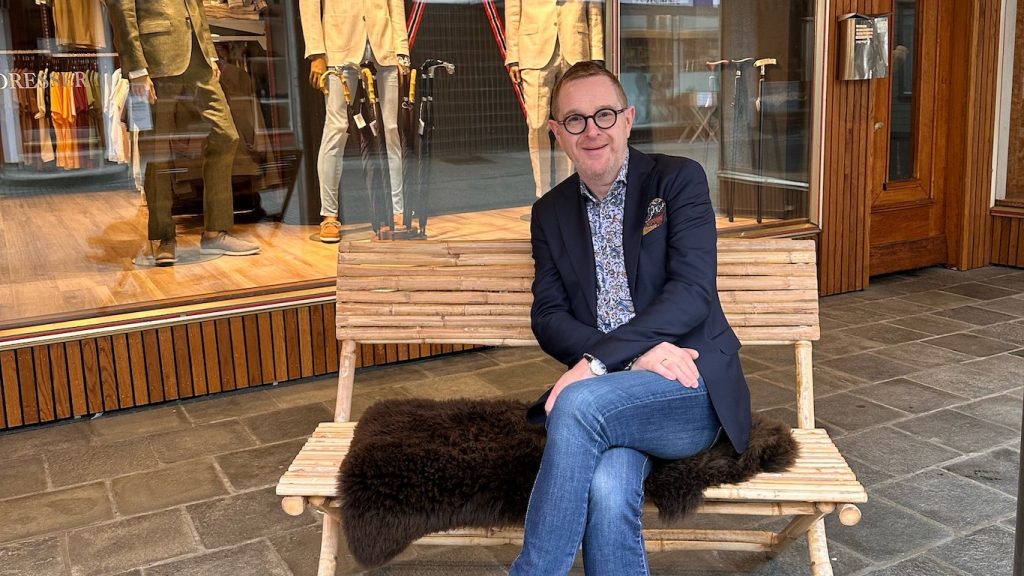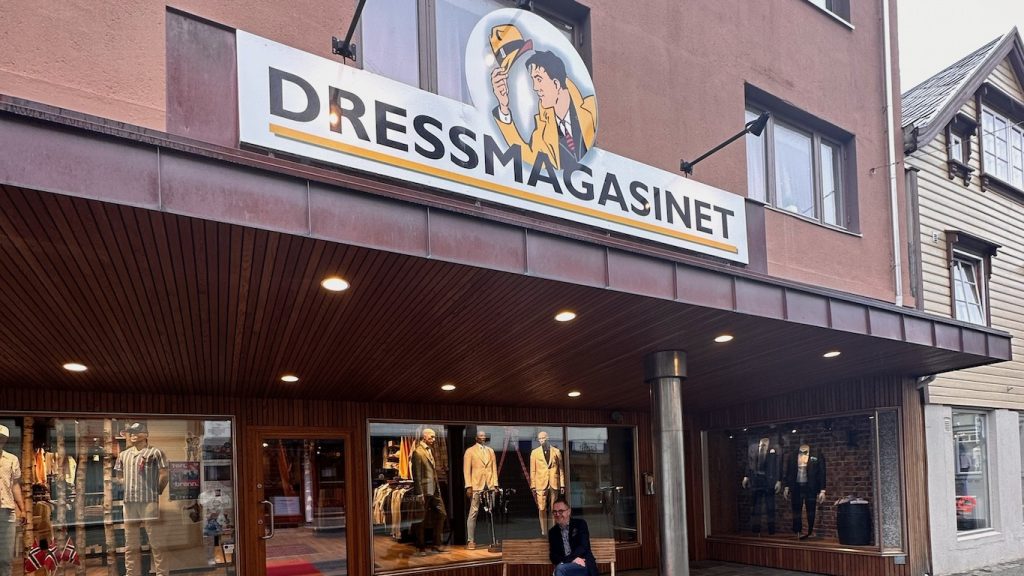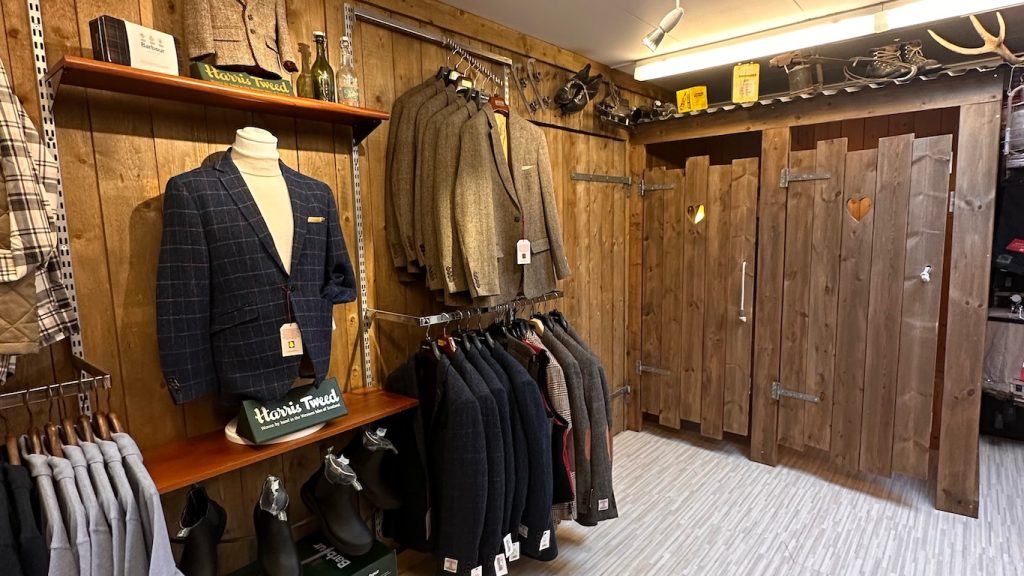A blend of Intuition and Luck
During the summer, people change their vacation plans to visit Egersund, and it’s all to see the Harris Tweed jackets at Dressmagasinet.

A Living Memorial
Dressmagasinet in Egersund has a unique history that goes back in time. In 1932, the store doors were opened for the first time by the well-known Haugesund Jew Moritz Rabinowitz. In addition to being a businessman, he was also a highly socially committed person who wrote hundreds of newspaper articles warning against Hitler and the dark forces threatening Europe. This made him a high-priority target for the Germans when they invaded Norway in 1940. The same year, he was captured and sent to a concentration camp in Germany, where he died in 1942.
The store in Egersund was then taken over by store employee Omund Ognedal, and later his son, before today’s owner Bernt Blitzner received the store keys in 2004.

The Dressmagasinet has exclusively sold men’s clothing for all its years of operation, a tradition it continues today. Alongside perpetuating the spirit of entrepreneurship, Blitzner also stewards a history he is determined to never be forgotten. “I wanted to honor what Rabinowitz did in his time,” he expresses.
Back to Fashion
As a 12-year-old, Blitzner himself worked in a clothing store located next to Dressmagasinet. His first job as a permanent employee was also in a clothing store. Later, he contributed to starting local Bohus furniture stores. When he eventually sold his shares, he was left with some money: “That’s when I saw an opportunity to return to an industry I really, really loved. And when the conditions were right, I also had the chance to join Texcon – and I just had to go for it.”
After taking over, Blitzner found several items in the store attic that once belonged to Moritz Rabinowitz. When the local community realized what he was doing, many of them contributed items that were part of the store’s history. Today, these objects are a part of the store’s interior.
“The collegial camaraderie is vital.”
Bernt Blitzner
How did he find his niche in the market? “It’s a bit about the history, but also about how I designed the store. I took the time to see which segments my competitors in the area were operating in, and I found that certain product groups were underrepresented. I decided to focus on these and create a unique product mix. It should fit the look I wanted in the store, but also be a product mix that I knew people wanted – one that would stand the test of time. And we’ve achieved that.”
From England to Egersund
According to Blitzner, the highly sought-after UBR is among the most pivotal brands they showcase. They started selling it around 2010: “We traveled to Stavanger and visited Rolfsen – just to look at the jackets. Then we contacted Dag Tresselt, the owner of UBR, and asked: ‘Is it possible for us to sell the jackets in Egersund?'”
And indeed, they succeeded, and this success isn’t limited to UBR; “There were brands that took me six years to bring into the store. But I never gave up! By the end, the people at Gant were probably so tired of me that they just handed the brand over,” Blitzner says jokingly.
Luck or intuition?
“Perhaps a combination. Sometimes, you need a stroke of luck, along with the necessary expertise in your field. You can’t simply go with the flow because that doesn’t work. So, a bit of business instinct and luck.”

Blitzner describes himself as “more than averagely anglophile”. This made it a given that they would carry Harris Tweed. This special brand has drawn customers to the store in Egersund from across Norway: “It’s quite exciting. In the summer, people often come in and say, ‘We made a detour to Egersund, solely to visit your store and look at the Harris Tweed jackets’,” he shares.
Securing the rights to sell such a prestigious brand as Harris Tweed is no small task. One could wonder, did he have to wage a battle for it?
“No, I was quite fortunate there. However, Harris Tweed only manufactures the fabrics, so I had to find a tailor factory in England that could deliver the right jackets. I found one, and I’ve been collaborating with them for many, many years.”
200 – 300 suits in stock
Strolling through the streets of Egersund, if one were to inquire with a local about Dressmagasinet’s unique qualities, what kind of response might be expected?
“I am fairly confident they would mention our expertise, everything we can offer in terms of tailored clothing. We excel in this area. We have a large suit department with 200-300 suits in stock, almost all the time. And I hope they have a good impression of the store; their experience and the atmosphere. We often receive feedback on these aspects. That makes me believe we’ve achieved something.”
“We have a motto: When a customer enters our store, they have a purpose. We understand there is a reason they’re visiting us, even if it’s just to look around. And we strive to establish a relationship from the moment the customer walks in.”
The staff is also taught that a customer is not truly a customer until they return: “The initial purchase creates the desire to return, but it’s the second purchase that makes them a customer,” Blitzner explains.
A New Generation?
Both of Blitzner’s sons are interested in fashion: The elder has worked at Follestad in Oslo for about ten years, while the younger has earned a retail diploma and is now a permanent employee at Dressmagasinet. The previous owners consisted of two generations – could history be repeating itself?
“I’m not planning to retire just yet, but both of them joined the store board last year – precisely so they can gain insight into what we’re doing.”
In the context of preparing the next generation, what could be the strategy for their development and grooming?
“Trial and error are important here. Additionally, we have an active city association here, which has been very good at providing various types of courses. I try to send them to every opportunity available. They should gather as much experience and learn as much as possible.”
“The fashion industry in Norway must be the smallest in the world. That’s why Texcon is so important.”
Bern Blitzner
Relationships are Important
Aside from being part of Texcon to stay updated, Blitzner says he has spent a lot of time building relationships within Texcon. “The collegial camaraderie is vital. And we’re talking about everything from store operations and accounting to fashion. There are four or five colleagues I talk to weekly, and we do a lot together.” When they go to trade fairs and meetings, they bring the next generation along: “We bring them along so they can do what we’ve done; to build these relationships. This way, they gain a foothold in this industry. Because no matter how you look at it, the fashion industry in Norway must be the smallest in the world. That’s why Texcon is so important. Also, when it comes to sustainability and environmental responsibility, we rely on a powerful engine like Texcon, which can chart the course and guide the direction we should take,” adds Blitzner.
Sweet Music Ahead
With few exceptions, Blitzner has mostly had profitable years since the inception of the business. He attributes this to relentless hard work and a clear concept.
“There aren’t many others doing what we do, like selling Lederhosen for a month every year. Not many others carried Harris Tweed. And as far as I know, there aren’t many others who host literary lectures in their store on a Saturday during prime time, or hold concerts in the store,” Blitzner chuckles. This is something they started when they no longer had space for their piano at home but found room for it in the store.
Nestled among Harris Tweed, Gant, Frislid, and Mortiz Rabinowitz’s old safe and office clock, there’s a white piano: “We thought, ‘why not have it in the store?’ So, all we had to do was tune it, bring in an artist, and hold concerts. And we plan to continue doing so!”